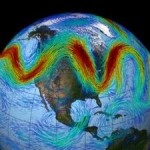
Relative temperature changes during last 160,000 years determined based on ice cores from Vostok station, Antarctica, (Petit et al., 1999). The periods when the Vistulian Glaciation ice-sheet probably covered north-eastern Poland are also shown (Behre K.E., 1989 – Biostratigraphy in the last glacial period in Europe. Quatern. Sc. Res. 8) Eemian Vistulian Glaciation ice-sheet cover in north-eastern Poland Pleistocene Holocene relative temperature changes time (thousands of years BP)
(Click here for Enlarged Image)
Geothermal modelling, performed based on the newest data from the Suwalki anomalous area, has shown that the rapid increase in temperature during ice-sheet retreat in north-eastern Poland was in excess of 18 Celsius degrees! (Šafanda, Szewczyk, Majorowicz, 2004, Geophysical Research Letters, No. 31). Thus, the previous opinion that the average temperature increase did not exceed 8 Celsius degrees, must be revised.
It should be stressed that, in contrast to polar areas where climatic changes during the Vistulian Glaciation were accompanied by considerable increase in ice thickness (e.g. >1500 m in central Antarctica – Petit et al. Nature 1999, Vol. 399), climatic changes in the Suwalki region during the same period were not associated with any change in deposit thickness – the total thickness of Vistulian Glaciation deposits is merely 6-10 m in this area. Reduced thicknesses significantly facilitate palaeotemperature calculation, so the modelling becomes more reliable.
Specific Conditions
Precise temperature measurements, performed in hydrogeological bore-holes of this region in 2003-2004, unambiguously confirmed the occurrence of both temperature inversion and the trend of increasing the inversion area towards the centre of the massif.
Analysis of factors that might have influenced the formation, and then preservation of such deep permafrost in the Suwalki region indicates that the simultaneous and independent occurrence of low heat-flow value and very porous highly water-saturated sedimentary overburden were of essential importance.

A preliminary model of permafrost deterioration in the Udryn region calculated in cooperation with the Geophysical Institute of the Academy of Sciences of the Czech Republic
(Click here for Enlarged Image)
Low heat-flow value, resulting from very low natural radioactivity of anorthosites composing the Suwalki Massif, was the reason for the occurrence of sub-zero temperatures down to a depth of nearly 600 m during the last glaciation. The overburden played a role of an insulating layer, contributing to the prolongation of the process of permafrost formation. However, the layer also retarded the process of permafrost degradation initiated when the climate rapidly got warmer.













